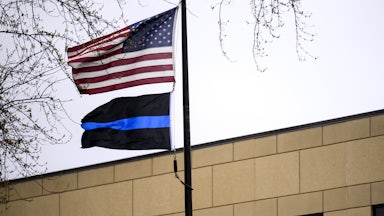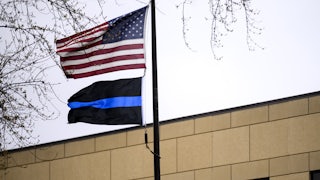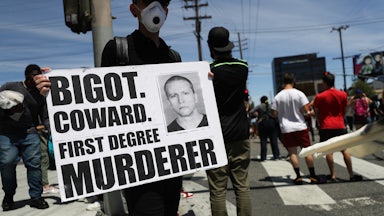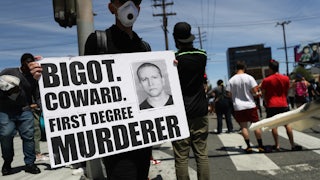At 4:10 p.m. local time on Tuesday, former Minneapolis police officer Derek Chauvin was remanded into custody, his bail revoked, guilty on all three counts of the murder of George Floyd. The state has prevailed in defining his acts as criminal, with guilt meant as accountability. But they can’t offer justice, not when their case rested on drawing a weak contrast between Chauvin’s death-dealing and the everyday violence of policing. And in truth, the guilty verdicts are unlikely to produce anything like safety.
As jurors and others file out of the courtroom on Tuesday, making their way home from the county building where the courthouse is located, they will encounter the fortification effort—concrete barriers, razor wire, checkpoints—resulting from something called Operation Safety Net. “This is about maintaining safety and security,” Deputy Police Chief Erick Fors said in February, describing the militarization of the city in the weeks before the trial. This is how the state defines safety, with blockades and with force.
The state’s reaction to the trial, to roll out a militarized response even before a verdict, is enough evidence to argue that what it feared was not any particular outcome in the courtroom but what unfolds in the streets. After last summer’s uprisings in the name of George Floyd, the man Chauvin has been convicted of murdering, city and state officials, with millions of dollars in funds from the state legislature, braced for whatever protest they anticipated would come. The “safety” they intended to establish with overwhelming police and national guard presence, in other words, is the safety of those imagined to be at risk due to unrest, even though we know—and it’s the whole reason for the trial in the first place—that law enforcement itself has the greatest capacity to inflict injury and death, something this trial cannot change.
At the same time, senior law enforcement leadership do not seem to understand, or concede, the threat they and their organizations pose. “We understand our communities, our cities, are going through a tough time,” Minneapolis Police Chief Medaria Arradondo told reporters April 15, as the trial was heading into closing arguments, in the midst of protests after a police officer in the nearby town of Brooklyn Center shot and killed Daunte Wright, as the National Guard presence in Minneapolis escalated. More than 50 community groups demanded an immediate end to Operation Safety Net. “We are horrified by the state’s preemptive force against its people, and the compounding trauma caused by the state against Black, brown, and Indigenous communities,” they wrote in an April 15 letter. “Executive leaders are fully in charge of this force and have the power to stop this harmful approach. Our communities have the right to live and protest without being terrorized by a militarized police force.” For all that state and law enforcement may “understand” the “tough time” the community is going through, they have escalated fears and tensions, increasing the risk of violence and calling it keeping the peace. It is also a way of maintaining their own power in the face of profound resistance. The state seeks not just a lock on violence but also on interpretation.
If anything, the trial and specifically the prosecution afforded Minneapolis law enforcement a stage on which to define violence and peace before an international audience, who could watch every moment on livestream. The defense sought to blame both Floyd and bystanders, not Chauvin, arguing that Chauvin’s actions were in fact reasonable because what he did that day, killing Floyd, is what any other “reasonable” officer might do. Yet the state repeated, again and again, that they were not there to put police on trial, that Chauvin was the only one on trial. They called members of law enforcement to the stand, including Chief Arradondo, to attest to the aberration of Chauvin’s actions. In fact, the state’s strategy seemed designed to win over jurors who saw something criminal in what Chauvin did but did not want to pass judgment on all police.
This is perhaps where jurors ultimately fell, even in pronouncing Chauvin guilty of murder. During the trial, watching videos of Chauvin and Floyd, one juror was overcome with stress and wanted out, at least for a moment. “Juror 44—a white woman in her 50s—suddenly waved to get Judge Cahill’s attention and asked to leave the courtroom due to a ‘stress-related reaction,’” reported the Star Tribune. “She’d been awake since 2 a.m. that day, unable to sleep, the juror said.” She had also said, during jury selection, that she had seen the bystander video: “Not all police are bad, but the bad-behavior police need to go.” She also, again as the Star Tribune described the scene, “acknowledged sympathy for Floyd and the officers at the scene that night, saying, ‘Everyone’s lives are changed by this incident … and it’s not easy for anyone.’”
All you need to do is trust your eyes, the prosecution advised the jury. You saw violence that day. Trust what you see on the bystander video. “You can believe your eyes,” prosecutor Steve Schleicher told the jury in his closing statement. Prosecutors defined the video of Chauvin against what they presented as the true reality of law enforcement—closing their case with the pronouncement, “This wasn’t policing. This was murder.”
The defense’s conception of policing was the more clear-eyed of the two. The use of force was not an aberration but a somber necessity, “as unattractive as that may be,” defense attorney Eric Nelson told the jury. Violence and peace don’t exist in antagonism, the argument went—one is required for the other.
The state’s position, inside the courtroom, appeared at odds with this, trying to reclaim the goodness of policing against the violence of murder. But the truth was more ambiguous, and tellingly so. They wanted to hold onto the power to call what Chauvin did a violent crime before the jury, while outside the courtroom, in the street, a scene of violence awaited them. Police were prepared to use all necessary force if, through protest, order was lost. What the state calls peace and safety.
While it is true, technically, that Derek Chauvin was the only one on trial, it is also fair to say that if not for the massive uprisings over police violence and murder, there may not have been a trial at all. That is the power at stake here, too, something that has less to gain from the courtroom proceedings than it does from harnessing collective anger and trauma. It’s the power built by middle and high school students walking out of class Monday in protest of racism and injustice, or by mutual aid work that has taken root around the site of George Floyd’s murder. It is something pointing toward safety without police. No verdict can deliver that, but what got us to the trial may yet.








